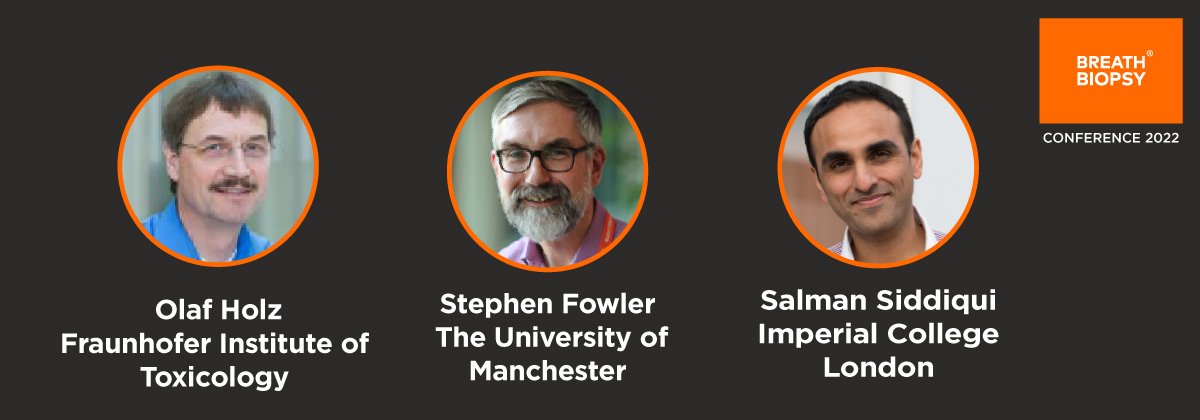Top breath research papers – as selected by the experts
Published on: 28 Nov 2022, under Breath Biopsy
At the Breath Biopsy Conference the round table panel discussion is always one of the most popular sessions. This year, on the 2nd of November, we asked our expert panelists about some of the biggest unanswered questions in breath research and enjoyed the resulting lively discussion, including some great contributions from the audience.
The panel discussion, in its entirety is now available to watch, or re-watch, on demand, alongside the other presentations from this year’s conference.
During this ‘Ask the Experts’ session each panelist shared their ‘top three advances or results in the breath research field over the last five years’. Some panelists discussed general developments in the field, such as increased standardization, a fresh emphasis on complementary in vivo and in vitro investigations, and the launch of Owlstone Medical’s VOC Atlas. However, others came prepared with specific papers that they considered to be particularly influential.
Read on for a run-down of the papers these panelists selected.
Salman Siddiqui Clinical Professor of Respiratory Medicine, Imperial College
- Z. Li, et al. Non-invasive plant disease diagnostics enabled by smartphone-based fingerprinting of leaf volatiles. Nat. Plants 5, 856–866 (2019). DOI: 10.1038/s41477-019-0476-y
‘A cracking paper looking at using integrated colourimetric sensors for tomato plants that have become infected with p. infestans. It demonstrates that just using the RGB sensors on a phone, with more than 95% accuracy, you can identify when tomato leaves are decaying. Given the fact that respiratory diagnostics are moving to remote diagnostics in the community, we want to move towards hardware free diagnostic interfaces. For me this was a controversial but really exciting paper [showing what can be done].’
- F.N. Schleich, et al. Exhaled Volatile Organic Compounds Are Able to Discriminate between Neutrophilic and Eosinophilic Asthma. Am J Respir Crit Care Med. 2019 Aug 15;200(4):444-453. DOI: 10.1164/rccm.201811-2210OC
‘The field in asthma has been riddled with relatively small studies. This paper by Schleich et al. was a comprehensive GC-GC discovery and replication study, including about 500 patients. It identified a small list of volatiles, largely aldehydes, helpful in predicting type II asthma. I think this is an important paper in the field.’
- W. Ibrahim, et al. Visualization of exhaled breath metabolites reveals distinct diagnostic signatures for acute cardiorespiratory breathlessness. Science Translation Medicine. 2022 Nov 16; 14(671). DOI: 10.1126/scitranslmed.abl5849
‘This is our own paper, it identifies GC-GC signatures of cardio-respiratory exacerbations in heart failure, asthma, pneumonia and COPD. This study will be a template for us to go back and look at the mechanisms of these exacerbation types and understand how volatiles in acute disease relate to actual pathology. I think that’s important because it could allow us to direct therapies to the right patients.’ [This paper used Owlstone’s ReCIVA Breath Sampler]
Stephen Fowler Professor of Respiratory Medicine, University of Manchester
- F. Kamal, et al. Virus-induced Volatile Organic Compounds Are Detectable in Exhaled Breath during Pulmonary Infection. Am J Respir Crit Care Med. 2021 Nov 1;204(9):1075-1085. DOI: 10.1164/rccm.202103-0660OC
‘I thought this was a very impressive series of studies that worked their way through from cells, to the healthy challenge model, to the real world. It certainly showed that the same classes of compounds were shifting [on breath] in the same direction after the same sort of challenge. I though the whole set-up of the study was great.’
- O. Holz, et al. Changes of breath volatile organic compounds in healthy volunteers following segmental and inhalation endotoxin challenge. J Breath Res. 2022; (16):037102. DOI: 10.1088/1752-7163/ac6359
‘This is one of Olaf’s studies. He gave people endotoxins as a whole lung challenge. The results are interesting – his discussion is really good. A lot of the things he found changing were aldehydes – in theory related to oxidative stress, but in practice ubiquitous in the environment as well. They’re a really good example of a group of compounds that biologically you can explain why they might be important, but when you get down to the detail of where they’re coming from in an individual it’s really hard. It was a heroic study!’
- W. Ahmed, et al. Microbial volatiles as diagnostic biomarkers of bacterial lung infection in mechanically ventilated patients. Clinical Infectious Diseases 2022 Oct 31: ciac859. DOI: 10.1093/cid/ciac859
‘This is one of ours, it’s a follow-on analysis from a breath study we did a couple of years ago, taking breath samples from patients at high risk of pneumonia, with pneumonia cases confirmed later bacteriologically. In this new paper Waqar Ahmed went back to in vitro cultures and looked to see what the VOC profile of the most common pathogens was. He noticed a collection of volatiles related to staphylococcus in culture and then went to look for those in the breath samples. It’s a mechanistic pathway through from cell culture to breath.’
Olaf Holz Fraunhofer Institute for Toxicology and Experimental Medicine (ITEM)
- N. Ratcliffe, et al. A mechanistic study and review of volatile products from peroxidation of unsaturated fatty acids: an aid to understanding the origins of volatile organic compounds from the human body. Journal or Breath Research 2020 Mar 13: 034001. DOI: 10.1088/1752-7163/ab7f9d
‘I often think: “Where are these exotic aldehydes [that we see on breath] coming from?” This paper demonstrates that there are metabolic processes, chemical pathways that can enable us to consider that these aldehydes may be endogenous, and not just [contaminants] from the outside’. For instance, octane is a jet fuel, but this paper shows that there are pathways in the body to produce it too.’
Watch the whole panel discussion
Looking for more recent advances in breath research? 25 scientific posters were submitted for presentation at BBCon22 – a new record high. You can watch the recordings of both Day 1 & Day 2’s poster sessions or browse the poster PDFs on our Community pages.
